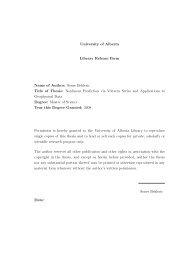Regularization of the AVO inverse problem by means of a ...
Regularization of the AVO inverse problem by means of a ...
Regularization of the AVO inverse problem by means of a ...
You also want an ePaper? Increase the reach of your titles
YUMPU automatically turns print PDFs into web optimized ePapers that Google loves.
CHAPTER 4. TWO-TERM <strong>AVO</strong> INVERSION 44<br />
this particular prior becomes<br />
P (mf |d) ∝ exp{− 1<br />
2 (d − Lf mf ) T Υ T C −1<br />
d Υ(d − Lf<br />
2N<br />
mf ) − ln(1 + (<br />
i=1<br />
mi f<br />
σ )2 }. (4.20)<br />
From which follows, <strong>the</strong> objective function<br />
where<br />
J uc (mf ) = 1<br />
2 (d − Lf mf ) T Υ T C −1<br />
d Υ(d − Lf mf ) + R uc (mf )} (4.21)<br />
R uc (mf ) =<br />
2N<br />
i=1<br />
ln(1 + ( mi f<br />
σ )2 ) (4.22)<br />
which is <strong>the</strong> regularization that comes from <strong>the</strong> Univariate Cauchy prior. The next step is<br />
to minimize <strong>the</strong> objective function. Differentiating J uc with respect to mf , we get<br />
where<br />
∂J uc (mf )<br />
∂mf<br />
= L T f Υ T C −1<br />
d ΥLf mf − L T f Υ T C −1<br />
d Υd + ∂Ruc (mf )<br />
∂R uc (mf )<br />
∂mf<br />
= 2<br />
Quc<br />
σ2 f mf<br />
∂mf<br />
and <strong>the</strong> matrix Q uc<br />
f is a (2N) × (2N) diagonal matrix whose elements are<br />
[(Q uc<br />
<br />
f )kk] = 1 +<br />
, (4.23)<br />
(4.24)<br />
k <br />
m 2−1 f<br />
. (4.25)<br />
σ<br />
The detail derivation for generalized Multivariate t distribution and <strong>the</strong> regularization is<br />
given in Appendix (A.2). Substituting equations (4.16) and (4.24) into equation (4.23), and<br />
setting <strong>the</strong> resulting expression to zero, we finally have<br />
where<br />
(L T f Υ T ΥLf + µ uc Q uc<br />
f )mf = L T f Υ T ΥLf d, (4.26)<br />
µ uc ∼ 2σ2 d<br />
σ 2<br />
which <strong>means</strong> <strong>the</strong> hyper-parameter µ uc is in <strong>the</strong> order <strong>of</strong> ratio <strong>of</strong> <strong>the</strong> noise variance and <strong>the</strong><br />
square <strong>of</strong> <strong>the</strong> scale parameter. The dependence <strong>of</strong> Q uc<br />
f on mf makes <strong>the</strong> <strong>inverse</strong> <strong>problem</strong><br />
non-linear unlike using <strong>the</strong> Gaussian probability distribution as a prior. The IRLS algorithm









